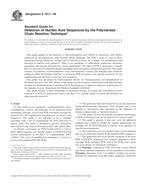Potřebujeme váš souhlas k využití jednotlivých dat, aby se vám mimo jiné mohly ukazovat informace týkající se vašich zájmů. Souhlas udělíte kliknutím na tlačítko „OK“.
ASTM E1873-06
Standard Guide for Detection of Nucleic Acid Sequences by the Polymerase Chain Reaction Technique (Withdrawn 2014)
Automaticky přeložený název:
Standardní Příručka pro odhalování Řetězce nukleové kyseliny podle polymerázové řetězové reakce Technique (Withdrawn 2014 )
NORMA vydána dne 1.11.2006
Informace o normě:
Označení normy: ASTM E1873-06
Poznámka: NEPLATNÁ
Datum vydání normy: 1.11.2006
Kód zboží: NS-43399
Počet stran: 9
Přibližná hmotnost: 27 g (0.06 liber)
Země: Americká technická norma
Kategorie: Technické normy ASTM
Anotace textu normy ASTM E1873-06 :
Keywords:
amplification, diagnosis, DNA probe, hybridization, PCR, polymerase chain reaction, primer, ICS Number Code 07.100.99 (Other standards related to microbiology)
Doplňující informace
| Significance and Use | ||
|
This guide is intended for use in any laboratory utilizing PCR or RT-PCR to amplify and detect a specific nucleic acid sequence. The criteria used for evaluation of the amplification reactions should be administered by an individual trained in the use of molecular biological techniques associated with PCR. |
||
| 1. Scope | ||
|
1.1 This guide covers guidelines, recommendations, basic considerations, criteria, and principles to be employed when developing, utilizing, or assessing PCR procedures and specific protocols for the amplification and detection of nucleic acid sequences. This guide is not intended to be a standard procedure with a list of requirements for PCR detection of nucleic acids. This guide is intended to provide information that will assist the user in obtaining quality and reliable data. 1.2 Nucleic acid targets for PCR include DNA, as well as RNA ; RNA sequences are suitable targets for PCR following reverse transcription of the RNA to complementary DNA (cDNA). This type of amplification technique is known as reverse transcription-PCR (RT-PCR). 1.3 This guide has been developed for use in any molecular biology/biotechnology laboratory. This includes, but is not limited to, laboratories that specialize in the diagnosis of human, animal, plant, or bacterial diseases. 1.4 This guide conveys the general procedural terminology of PCR technology used for the detection of nucleic acids. 1.5 This guide is general; it does not cover the additional guidance that would be needed for specific applications, for example, for the PCR detection of nucleic acid sequences of specific microorganisms. 1.6 This guide does not cover details of the various methods that can be utilized to identify PCR-amplified DNA sequences. 1.7 This guide does not cover specific variations of the basic PCR or RT-PCR technology (for example, quantitative PCR, real-time PCR, multiplex PCR, and in situ PCR), and it does not cover details of instrument calibration. 1.8 Warning-Laboratory work involving certain clinical specimens and microorganisms can be hazardous to personnel. Warning-Biosafety level 2 (or higher) facilities are recommended for biohazard work (). Safety guidelines should be adhered to in accordance with CLSI M29-A2 and other recommendations (). |
||
| 2. Referenced Documents | ||
|
Doporučujeme:
EviZak - všechny zákony včetně jejich evidence na jednom místě
Poskytování aktuálních informací o legislativních předpisech vyhlášených ve Sbírce zákonů od roku 1945.
Aktualizace 2x v měsíci !
Chcete vědět více informací? Podívejte se na tuto stránku.




 Cookies
Cookies
